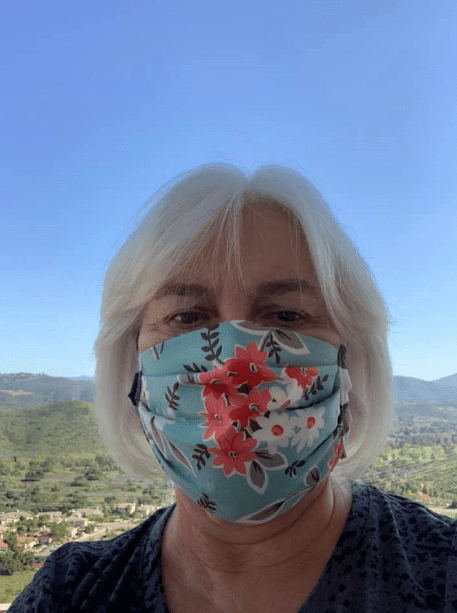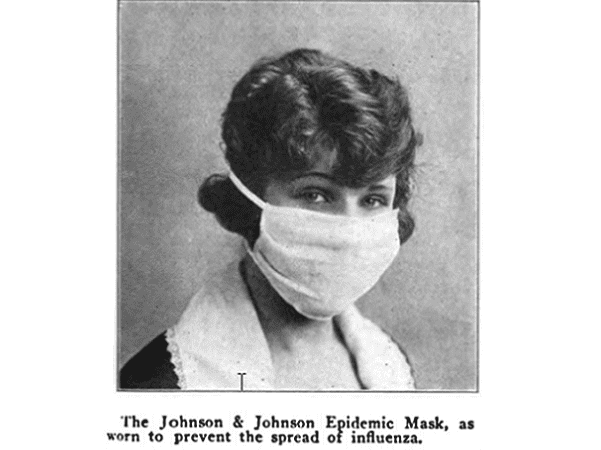Introduction: In this article – to provide help and perspective in this time of the coronavirus pandemic – Gena Philibert-Ortega describes how our ancestors used masks during the 1918 flu pandemic. Gena is a genealogist and author of the book “From the Family Kitchen.”
One of the requirements where I live is that we must wear masks whenever we leave our home to conduct “essential” business like grocery shopping. Are you wearing a mask when you leave your home?
Many of my online friends are sewing masks to be used by their family and friends, and also donated to first responders and health care professionals.

The Daughters of the American Revolution (DAR) members hit a milestone recently by sewing more than 107,000 masks to donate to essential workers and those in need. (1) Online you can find face mask patterns that can be sewn, or made without sewing.
One of the ways historians are educating the public about COVID-19 is by comparing this pandemic with the 1918 influenza pandemic (also referred to as the Spanish flu). There are many commonalities between the two and, as you probably have seen via vintage photos, our ancestors wore masks back then as well.
Masks Then
The influenza outbreak began in March 1918, and then between September and November 1918 a second wave started.
Lori Lyn Price, social historian and writer at 1918.flustories.com, says that on the East Coast:
“Boston was ground zero for the 2nd wave of the flu in the late summer and fall of 1918, with the first civilian deaths in mid-September. Initially only caregivers were told to wear masks. But soon the Boston area was encouraged to stay away from crowds, and when that was impossible to use a handkerchief to cover the mouth and nose. Mask use was not universal, but many cities did eventually require their use.” (2)
By October 1918 cities were encouraging their citizens to wear a mask and for good reason: 195,000 Americans died that month from the flu. (3)
A Phoenix, Arizona, newspaper article from 26 October 1918 reported the first sighting of someone in town wearing an “influenza mask.” The article also provided instructions for making one.
According to this article:
“The influenza mask is easily made. The most approved one is of several layers of coarse cheese cloth, but some of the masks seen on the street yesterday were merely handkerchiefs. The cheese cloth mask of several thicknesses is the best and most serviceable mask and is the one the doctors recommend.”
Just as today, each state made decisions on whether to order its citizens to wear masks and when. This 26 October 1918 newspaper article from Salt Lake City, Utah, explained that masks were recommended – but not mandatory, because of the lack of masks available.
This article reported:
“An order making the universal wearing of masks compulsory, such as has been promulgated locally in various communities under the advice of the state board of health, has been considered for several days; but practical difficulties, such as the inadequate supply of materials for manufacture of the masks, has made this inadvisable until these difficulties have been overcome. All persons are urged however, to procure their own masks and wear them whenever they come in contact with other persons.
“The order making the wearing of the masks compulsory has been deferred for the present, but will be put into effect unless the public will do this as a voluntary measure for its own protection. If one life in the state of Utah is saved by the wearing of masks, the general inconvenience occasioned thereby will have been justified. When persons consider the saving of that one life, especially as it may be their own life, they will be willing to suffer the inconvenience of wearing masks.”
According to the Influenza Encyclopedia, San Francisco, California, was one of the first cities to mandate mask wearing. On 18 October 1918, the city health officer ordered:
“…that all barbers wear masks while with customers, and recommended clerks who came into contact with the general public also don them. The next day, [he] added hotel and rooming house employees, bank tellers, druggists, store clerks, and any other person serving the public to the list of those required to wear masks.”
By October 21st all residents were told to wear them in public:
“The wearing of a mask immediately became a symbol of wartime patriotism. A Red Cross public service announcement stated bluntly, ‘the man or woman or child who will not wear a mask now is a dangerous slacker,’ calling into question the patriotism of those who refused.” (4)
And what happened if they didn’t wear a mask? They were arrested, sentenced, and fined, with monies collected going to the Red Cross. Sometimes they were even given jail sentences.
Non-mask wearers were arrested for disturbing the peace and, as this article reported:
“Judge Brady gave each prisoner before him a lecture on the neglect to wear a mask and promised stern measures in his court in future cases.”
This article also reported on one case in which the defendant:
“John Raggi, arrested on Columbus avenue, said he did not wear a mask because he did not believe in masks, or ordinances, or even in jails. John did not believe in the draft either, and had no registration card [World War I]. He has now no occasion to disbelieve in jails. He is in the City Prison.”
Mask DYI
If you’re using social networking websites, you’ve no doubt seen all kinds of tutorials for making masks. In 1918 flu masks were largely made of gauze, though I have seen mentions of using handkerchiefs and even glove manufacturers selling masks made of silk.
Did our ancestors make their own influenza masks? They could have. Instructions were printed in periodicals and newspapers. This California State Board of Health “Bulletin on Influenza” by Wilfred H. Kellogg, published in January 1919, provided instructions for making masks which suggested layers of gauze or “butter cloth” sewn together and then “tapes” that would allow the mask to be tied to the face. (5)
Newspapers also provided information on making masks, such as these December 1918 instructions from the Fort Wayne News Sentinel that used gauze and a safety pin for those who were unable to sew.
What Did Your Ancestor Wear?
The “Red Cross Notes” published by Johnson & Johnson gave information about the use of masks (of course, they were producing gauze used in masks at this time):
“Gauze masks were found to be an effective means of preventing the spread of influenza during the recent epidemic. In some communities the wearing of the masks in public places was made compulsory.” (6)
This is one of those times I wish my ancestors either wrote about their experiences or took more photos. I’d be interested in what type of masks they wore and their thoughts about it. I’d also be interested if they answered the call by the Red Cross to help with making masks.
As I document my own experience with our current pandemic, the one thing that I have marveled at watching is the many DAR members and others who have answered the call to make masks. They’ve shared creative ideas for patterns, dug into their beautiful quilt fabric stashes, and lined up to pick up materials. Just like 100 years ago when the Red Cross asked American women to “knit their bit” for the war effort, modern day citizens are doing their bit to help everyone be a little safer.
_________________
(1) “DAR Homemade Mask Count Surpasses 100,000,” DAR (https://blog.dar.org/dar-homemade-mask-count-surpasses-100000: accessed 19 April 2020).
(2) Message to Gena Philibert-Ortega from Lori Lyn Price, MAS, MLA, 19 April 2020.
(3) “1918 Pandemic Influenza Historic Timeline,” Centers for Disease Control and Prevention (accessed 19 April 2020).
(4) “San Francisco, California,” Influenza Encyclopedia (https://www.influenzaarchive.org/cities/city-sanfrancisco.html#: accessed 20 April 2020).
(5) Kellogg, Wilfred H. Influenza: A Study of Measures Adopted for the Control of the Epidemic. United States, California State Printing Office, 1919. Available via Google Books https://www.google.com/books/edition/Influenza/R_o1AQAAMAAJ?hl=en&gbpv=0
(6) Red Cross Notes. Series VII. Number 11. 1919. Pg. 289 Available on Google Books https://www.google.com/books/edition/Red_Cross_Notes/1n0CAAAAYAAJ?hl=en&gbpv=0
Related Articles:
